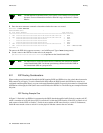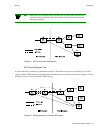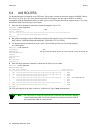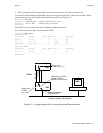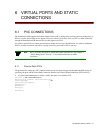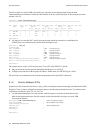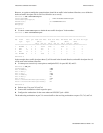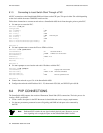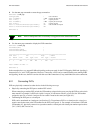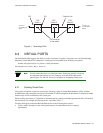6-2 SmartSwitch 6500 User Guide
PVC Connections Virtual Ports and Static Connections
For this example, we specify CBR as the traffic type, then take the remaining defaults. Enter the show
trafficdescriptor
command to obtain the index number of the new traffic descriptor. In this example, the index
number is two (2).
Smart6500 # show trafficdescriptor
========================================================================================
TD# Traff Desc QoS Peak Cell Rate Sust Cell Rate Max Burst Size Min Cell Aal Type
Type Type (Kb/s) (Kb/s) (Kb/s) Rate
CLP_0 CLP_0+1 CLP_0 CLP_0+1 CLP_0 CLP_0+1 (Kb/s)
=========================================================================================
1 NRTVBR 7 0 0 10872 5436 0 2052 0 0 5
2 CBR 2 1 0 100 0 0 0 0 0 5
176 NRTVBR 2 1 0 1585 0 0 0 0 0 5
Smart6500 #
2. Use add pvc to create the PVC; specify the ports through which the connection is established, the
VPI/VCI pair to use with each port, and the traffic descriptor to use.
Smart6500 # add pvc
ConnType(PTP) :
Port-1-Number() : 7a1
< Specify first port
Port-1-VPCI() : 0
< Specify its VPCI
Port-1-VCI() : 100
< Specify its VCI
Port-2-Number() : 7b2
< Specify second port
Port-2-VPCI() : 0
< Specify its VPCI
Port-2-VCI() : 100
< Specify its VCI
Port1-to-Port2TrafficDescriptorIndex() : 2
< We use our traffic descriptor
Port2-to-Port1TrafficDescriptorIndex() : 2
Smart6500 #
The example above creates a PVC between ports 7a1 and 7b2 with VPCI/VCI = 0/100.
3. Plug the end nodes into the specified SmartSwitch 6500 ports (7a1 and 7b2).
4. Configure each end node with the proper IP address, subnet mask, and VPCI/VCI pair = 0/100.
The end nodes can communicate with each other through the point-to-point PVC connection.
6.1.2 Point-to-Multipoint PVCs
Instructions in this section describe how to set up a point-to-multipoint connection through your SmartSwitch 6500.
Example: Create a point-to-multipoint connection between a broadcasting workstation on port 7a1 and three other
workstations connected to ports 7a2, 7a3, and 7a4.
1. Use add trafficdescriptor to create two new traffic descriptors, one for the forward direction, the
other for the backward direction. For this example, for the forward traffic descriptor, we select UBR
and accept the defaults.
Smart6500 # add trafficdescriptor
< This is the forward descriptor
TrafficType(UBR) :
< We use UBR for this example
TrafficDescriptorType(11) :
PCRCLP01(100) :
< Take the default values
QOSCLASS(0) :
AalType(5) :
Smart6500 #



